Simulation Analysis of Issues with Grid Disturbance for a Photovoltaic Powered Virtual Synchronous Machine
Abstract
:1. Introduction
- Adding inertia such as a synchronous condenser;
- Increasing the allowable range of frequency fluctuation in the system;
- Providing fast frequency control (FFC) ancillary service from IBRs.
- Use of kinetic energy inside IBRs, such as turbine blades;
- Use of fast-responding energy storage systems (ESSs) such as batteries and capacitor banks;
- Reserve capacity from the IBR source’s headroom.
- If the headroom of the PV-VSM is insufficient for the required FFR output, PV-VSMs without adequate control of the upper output limit (output limiter) will become unstable in operation. Note that insufficient headroom can be caused by solar radiation fluctuations as well as frequency fluctuations.
- The introduction of output limiters to PV-VSMs with maximum power estimation can prevent PV-VSM instability due to a lack of headroom or solar radiation fluctuations.
- However, in case the PV-VSMs’ planned generation is high for their headroom, there is a risk of grid instability due to reduced solar radiation. The instability is caused by PV-VSMs being in output-specified control mode (Grid Follow) due to reduced headroom; that is, estimated PV-VSMs’ virtual energy disappears and causes more imbalance. Consequently, insufficient Primary Frequency Response (PFR) from the synchronous machine becomes impossible to compensate rapid frequency reduction by insufficient grid inertia. Therefore, care must be taken to cope with reduced solar radiation during operation of the reserve power supply by the headroom.
2. Simulation Model
2.1. Photovoltaic Powered Virtual Synchronous Machine
- (1)
- Maximum power point tracking (MPPT);
- (2)
- Constant voltage control for the primary side of the converter;
- (3)
- Constant voltage control for the secondary side of the converter.
2.2. Two-Generator System Model
- Step changing load power fluctuation for the PV-VSM with insufficient headroom;
- Ramp changing irradiance fluctuation for the PV-VSM.
3. Simulation of the Step Changing Load Power Fluctuation
4. Photovoltaic Powered Virtual Synchronous Machine with a Limiter Control System
4.1. Scheme of the Limiter Control System
4.2. Simulation Results for Solar Power Fluctuation
4.3. Simulation Results for Load Fluctuation
5. Conclusions
Author Contributions
Funding
Institutional Review Board Statement
Informed Consent Statement
Data Availability Statement
Conflicts of Interest
References
- IPCC: 2018 Global Warming of 1.5 °C An IPCC Special Report on the Impacts of Global Warming of 1.5 °C above Pre-Industrial Levels and Related Global Greenhouse Gas Emission Pathways, in the Context of Strengthening the Global Response to the Threat of Climate Change, Sustainable Development, and Efforts to Eradicate Poverty. Available online: https://www.ipcc.ch/site/assets/uploads/sites/2/2019/06/SR15_Full_Report_High_Res.pdf (accessed on 13 April 2022).
- UNFCCC Authors, Glasgow Climate Change Conference—OctoberNovember 2021 Decisions. 13 November 2021. Available online: https://unfccc.int/sites/default/files/resource/cop26_auv_2f_cover_decision.pdf (accessed on 12 April 2022).
- IEA. Net Zero by 2050; IEA: Paris, France, 2021; Available online: https://www.iea.org/reports/net-zero-by-2050 (accessed on 12 April 2022).
- METI. Outline of the Basic Energy Plan; METI: Tokyo, Japan, 2020; Available online: https://www.meti.go.jp/press/2021/10/20211022005/20211022005-2.pdf (accessed on 12 April 2022).
- METI. FY2020 Energy Supply and Demand Results (Preliminary [Announced on 26 November 2021]); METI: Tokyo, Japan, 2020; Available online: https://www.enecho.meti.go.jp/statistics/total_energy/pdf/gaiyou2020fyr.pdf (accessed on 12 April 2022).
- Denholm, P.; Mai, T.; Kenyon, R.W.; Kroposki, B.; O’Malley, M. Inertia and the Power Grid: A Guide without the Spin (No. NREL/TP-6A20-73856); National Renewable Energy Lab. (NREL): Golden, CO, USA, 2020. Available online: https://www.nrel.gov/docs/fy20osti/73856.pdf (accessed on 12 April 2022).
- Christensen, P.; Andersen, G.K.; Seidel, M.; Bolik, S.; Engelken, S.; Knueppel, T.; Krontiris, A.; Wuerflinger, K.; Bülo, T.; Jahn, J.; et al. High Penetration of Power Electronic Interfaced Power Sources and the Potential Contribution of Grid Forming Converters, ENTSO-E Technical Report. 2020, pp. 1–61. Available online: https://strathprints.strath.ac.uk/72581/1/ENTSO_E_2020_High_Penetration_of_Power_Electronic_Interfaced_Power_Sources.pdf (accessed on 12 April 2022).
- Ullah, N.; Ali, A.; Ali, H.; Mahmood, K. Frequency stability and synthetic inertia. Var. Scalability Stab. Microgrids 2019, 139, 377. [Google Scholar]
- Hoke, A.; Mahmud, R.; Nelson, A.; Pattabiraman, D.; Asano, M.; Arakawa, D.; Ifuku, E. Fast Grid Frequency Support from Distributed Energy Resources (No. NREL/TP-5D00-71156); National Renewable Energy Lab. (NREL): Golden, CO, USA, 2021. [Google Scholar]
- IEA. System Integration of Renewables; IEA: Paris, France, 2018; Available online: https://www.iea.org/reports/system-integration-of-renewables (accessed on 12 April 2022).
- Liu, J.; Miura, Y.; Ise, T. Comparison of dynamic characteristics between virtual synchronous generator and droop control in inverter-based distributed generators. IEEE Trans. Power Electron. 2015, 31, 3600–3611. [Google Scholar] [CrossRef]
- Delille, G.; Francois, B.; Malarange, G. Dynamic frequency control support by energy storage to reduce the impact of wind and solar generation on isolated power system’s inertia. IEEE Trans. Sustain. Energy 2012, 3, 931–939. [Google Scholar] [CrossRef]
- Hirase, Y.; Abe, K.; Sugimoto, K.; Shindo, Y. A grid-connected inverter with virtual synchronous generator model of algebraic type. Electr. Eng. Jpn. 2013, 184, 10–21. [Google Scholar] [CrossRef]
- Zhong, Q.C.; Weiss, G. Synchronverters: Inverters that mimic synchronous generators. IEEE Trans. Ind. Electron. 2010, 58, 1259–1267. [Google Scholar] [CrossRef]
- Zhong, Q.C. Virtual Synchronous Machines: A unified interface for grid integration. IEEE Power Electron. Mag. 2016, 3, 18–27. [Google Scholar] [CrossRef]
- Sakimoto, K.; Miura, Y.; Ise, T. Stabilization of a power system with a distributed generator by a virtual synchronous generator function. In Proceedings of the 8th International Conference on Power Electronics-ECCE Asia, Jeju, Korea, 29 May–2 June 2011; pp. 1498–1505. [Google Scholar]
- Alipoor, J.; Miura, Y.; Ise, T. Power system stabilization using virtual synchronous generator with alternating moment of inertia. IEEE J. Emerg. Sel. Top. Power Electron. 2014, 3, 451–458. [Google Scholar] [CrossRef]
- Beck, H.P.; Hesse, R. Virtual synchronous machine. In Proceedings of the 2007 9th International Conference on Electrical Power Quality and Utilisation, Barcelona, Spain, 9–11 October 2007; pp. 1–6. [Google Scholar]
- Hesse, R.; Turschner, D.; Beck, H.P. Micro grid stabilization using the virtual synchronous machine (VISMA). In Proceedings of the International Conference on Renewable Energies and Power Quality (ICREPQ’09), Valencia, Spain, 15–17 April 2009; pp. 15–17. [Google Scholar]
- Chen, Y.; Hesse, R.; Turschner, D.; Beck, H.P. Investigation of the virtual synchronous machine in the island mode. In Proceedings of the 2012 3rd IEEE PES Innovative Smart Grid Technologies Europe (ISGT Europe), Berlin, Germany, 14–17 October 2012; pp. 1–6. [Google Scholar]
- Fazeli, M.; Holland, P. Universal and seamless control of distributed resources-energy storage for all operational scenarios of microgrids. IEEE Trans. Energy Convers. 2017, 32, 963–973. [Google Scholar] [CrossRef]
- Cheema, K.M. A comprehensive review of virtual synchronous generator. Int. J. Electr. Power Energy Syst. 2020, 120, 106006. [Google Scholar] [CrossRef]
- Mallemaci, V.; Mandrile, F.; Rubino, S.; Mazza, A.; Carpaneto, E.; Bojoi, R. A comprehensive comparison of Virtual Synchronous Generators with focus on virtual inertia and frequency regulation. Electr. Power Syst. Res. 2021, 201, 107516. [Google Scholar] [CrossRef]
- Muftau, B.; Fazeli, M. The Role of Virtual Synchronous Machines in Future Power Systems: A Review and Future Trends. Electr. Power Syst. Res. 2022, 206, 107775. [Google Scholar] [CrossRef]
- Loutan, C.; Klauer, P.; Chowdhury, S.; Hall, S.; Morjaria, M.; Chadliev, V.; Milam, N.; Milan, C.; Gevorgian, V. Demonstration of Essential Reliability Services by a 300-MW Solar Photovoltaic Power Plant (No. NREL/TP-5D00-67799); National Renewable Energy Lab. (NREL): Golden, CO, USA, 2017. Available online: https://www.nrel.gov/docs/fy17osti/67799.pdf (accessed on 12 April 2022).
- Dreidy, M.; Mokhlis, H.; Mekhilef, S. Inertia response and frequency control techniques for renewable energy sources: A review. Renew. Sustain. Energy Rev. 2017, 69, 144–155. [Google Scholar] [CrossRef]
- Yuan, H.; Tan, J.; Zhang, Y.; Murthy, S.; You, S.; Li, H.; Su, Y.; Liu, Y. Machine Learning-Based PV Reserve Determination Strategy for Frequency Control on the WECC System. In Proceedings of the 2020 IEEE Power & Energy Society Innovative Smart Grid Technologies Conference (ISGT), Washington, DC, USA, 17–20 February 2020; pp. 1–5. [Google Scholar]
- Su, Y.; Li, H.; Cui, Y.; You, S.; Ma, Y.; Wang, J.; Liu, Y. An adaptive PV frequency control strategy based on real-time inertia estimation. IEEE Trans. Smart Grid 2020, 12, 2355–2364. [Google Scholar] [CrossRef]
- Liu, J.; Yang, D.; Yao, W.; Fang, R.; Zhao, H.; Wang, B. PV-based virtual synchronous generator with variable inertia to enhance power system transient stability utilizing the energy storage system. Prot. Control. Mod. Power Syst. 2017, 2, 1–8. [Google Scholar] [CrossRef]
- Quan, X.; Yu, R.; Zhao, X.; Lei, Y.; Chen, T.; Li, C.; Huang, A.Q. Photovoltaic synchronous generator: Architecture and control strategy for a grid-forming PV energy system. IEEE J. Emerg. Sel. Top. Power Electron. 2019, 8, 936–948. [Google Scholar] [CrossRef]
- Rajan, R.; Fernandez, F.M.; Yang, Y. Primary frequency control techniques for large-scale PV-integrated power systems: A review. Renew. Sustain. Energy Rev. 2021, 144, 110998. [Google Scholar] [CrossRef]
- Rathnayake, D.B.; Akrami, M.; Phurailatpam, C.; Me, S.P.; Hadavi, S.; Jayasinghe, G.; Zabihi, S.; Bahrani, B. Grid Forming Inverter Modeling, Control, and Applications. IEEE Access 2021, 9, 114781–114807. [Google Scholar] [CrossRef]
- Ding, X.; Lan, T.; Dong, H. Control strategy and stability analysis of virtual synchronous generators combined with photovoltaic dynamic characteristics. J. Power Electron. 2019, 19, 1270–1277. [Google Scholar]
- Feldmann, D.; de Oliveira, R.V. Operational and control approach for PV power plants to provide inertial response and primary frequency control support to power system black-start. Int. J. Electr. Power Energy Syst. 2021, 127, 106645. [Google Scholar] [CrossRef]
- Zhang, X.; Gao, Q.; Hu, Y.; Zhang, H.; Guo, Z. Active power reserve photovoltaic virtual synchronization control technology. Chin. J. Electr. Eng. 2020, 6, 1–6. [Google Scholar] [CrossRef]
- Yan, X.; Li, J.; Wang, L.; Zhao, S.; Li, T.; Lv, Z.; Wu, M. Adaptive-MPPT-based control of improved photovoltaic virtual synchronous generators. Energies 2018, 11, 1834. [Google Scholar] [CrossRef]
- Jietan, Z.; Linan, Q.; Pestana, R.; Fengkui, L.; Libin, Y. Dynamic frequency support by photovoltaic generation with “synthetic” inertia and frequency droop control. In Proceedings of the 2017 IEEE Conference on Energy Internet and Energy System Integration (EI2), Beijing, China, 26–28 November 2017; IEEE: Piscataway, NJ, USA, 2017; pp. 1–6. [Google Scholar]
- Águila-León, J.; Chiñas-Palacios, C.D.; Vargas-Salgado, C.; Hurtado-Perez, E.; García, E.X. Optimal PID Parameters Tunning for a DC-DC Boost Converter: A Performance Comparative Using Grey Wolf Optimizer, Particle Swarm Optimization and Genetic Algorithms. In Proceedings of the 2020 IEEE Conference on Technologies for Sustainability (SusTech), Santa Ana, CA, USA, 23–25 April 2020; IEEE: Piscataway, NJ, USA, 2020; pp. 1–6. [Google Scholar]
- Águila-León, J.; Chiñas-Palacios, C.D.; Vargas-Salgado, C.; Hurtado-Perez, E.; García, E.X. Particle Swarm Optimization, Genetic Algorithm and Grey Wolf Optimizer Algorithms Performance Comparative for a DC-DC Boost Converter PID Controller. Adv. Sci. Technol. Eng. Syst. J. 2021, 6, 619–625. [Google Scholar] [CrossRef]
- Inoue, T.; Taniguchi, H. Development of Standard Models and Parametervalnes of Thermal Power Plants for Power System Dynamics Analysis; Central Research Institute of Electric Power Industry (CRIEPI): Chiyoda City, Japan, 1991; Available online: https://criepi.denken.or.jp/hokokusho/pb/reportDetail?reportNoUkCode=T91007 (accessed on 12 April 2022).
- Qoria, T.; Gruson, F.; Colas, F.; Kestelyn, X.; Guillaud, X. Current limiting algorithms and transient stability analysis of grid-forming VSCs. Electr. Power Syst. Res. 2020, 189, 106726. [Google Scholar] [CrossRef]
- Gkountaras, A.; Dieckerhoff, S.; Sezi, T. Evaluation of current limiting methods for grid forming inverters in medium voltage microgrids. In Proceedings of the 2015 IEEE Energy Conversion Congress and Exposition (ECCE), Montreal, QC, Canada, 20–24 September 2015; pp. 1223–1230. [Google Scholar]
- Huang, L.; Xin, H.; Wang, Z.; Zhang, L.; Wu, K.; Hu, J. Transient stability analysis and control design of droop-controlled voltage source converters considering current limitation. IEEE Trans. Smart Grid 2017, 10, 578–591. [Google Scholar] [CrossRef]
- Bottrell, N.; Green, T.C. Comparison of current-limiting strategies during fault ride-through of inverters to prevent latch-up and wind-up. IEEE Trans. Power Electron. 2013, 29, 3786–3797. [Google Scholar] [CrossRef]
- Paquette, A.D.; Divan, D.M. Virtual impedance current limiting for inverters in microgrids with synchronous generators. IEEE Trans. Ind. Appl. 2014, 51, 1630–1638. [Google Scholar] [CrossRef]
- Orihara, D.; Taoka, H.; Kikusato, H.; Hashimoto, J.; Otani, K.; Takamatsu, T.; Oozeki, T.; Matsuura, T.; Miyazaki, S.; Hamada, H.; et al. Internal Induced Voltage Modification for Current Limitation in Virtual Synchronous Machine. Energies 2022, 15, 901. [Google Scholar] [CrossRef]
- Zhu, Y.; Wen, H.; Chu, G. Active power control for grid-connected photovoltaic system: A review. In Proceedings of the 2020 IEEE/IAS Industrial and Commercial Power System Asia (I&CPS Asia), Weihai, China, 13–15 July 2020; pp. 1506–1511. [Google Scholar]
- Li, X. Maximum Power Point Tracking and Power Reserve Control for Photovoltaic System. Ph.D. Thesis, The University of Liverpool, Liverpool, UK, 2019. [Google Scholar]
- Hoke, A.; Muljadi, E.; Maksimovic, D. Real-time photovoltaic plant maximum power point estimation for use in grid frequency stabilization. In Proceedings of the 2015 IEEE 16th workshop on Control and Modeling for Power Electronics (COMPEL), Vancouver, BC, Canada, 12–15 July 2015; pp. 1–7. [Google Scholar]
- Hoke, A.F.; Shirazi, M.; Chakraborty, S.; Muljadi, E.; Maksimovic, D. Rapid active power control of photovoltaic systems for grid frequency support. IEEE J. Emerg. Sel. Top. Power Electron. 2017, 5, 1154–1163. [Google Scholar] [CrossRef]
- Sangwongwanich, A.; Yang, Y.; Blaabjerg, F. A sensorless power reserve control strategy for two-stage grid-connected PV systems. IEEE Trans. Power Electron. 2017, 32, 8559–8569. [Google Scholar] [CrossRef]
- Sangwongwanich, A.; Yang, Y.; Blaabjerg, F.; Sera, D. Delta power control strategy for multistring grid-connected PV inverters. IEEE Trans. Ind. Appl. 2017, 53, 3862–3870. [Google Scholar] [CrossRef]
- Batzelis, E.I.; Kampitsis, G.E.; Papathanassiou, S.A. Power reserves control for PV systems with real-time MPP estimation via curve fitting. IEEE Trans. Sustain. Energy 2017, 8, 1269–1280. [Google Scholar] [CrossRef]
- Batzelis, E.I.; Papathanassiou, S.A.; Pal, B.C. PV system control to provide active power reserves under partial shading conditions. IEEE Trans. Power Electron. 2018, 33, 9163–9175. [Google Scholar] [CrossRef]
- Li, X.; Wen, H.; Zhu, Y.; Jiang, L.; Hu, Y.; Xiao, W. A novel sensorless photovoltaic power reserve control with simple real-time MPP estimation. IEEE Trans. Power Electron. 2018, 34, 7521–7531. [Google Scholar] [CrossRef]



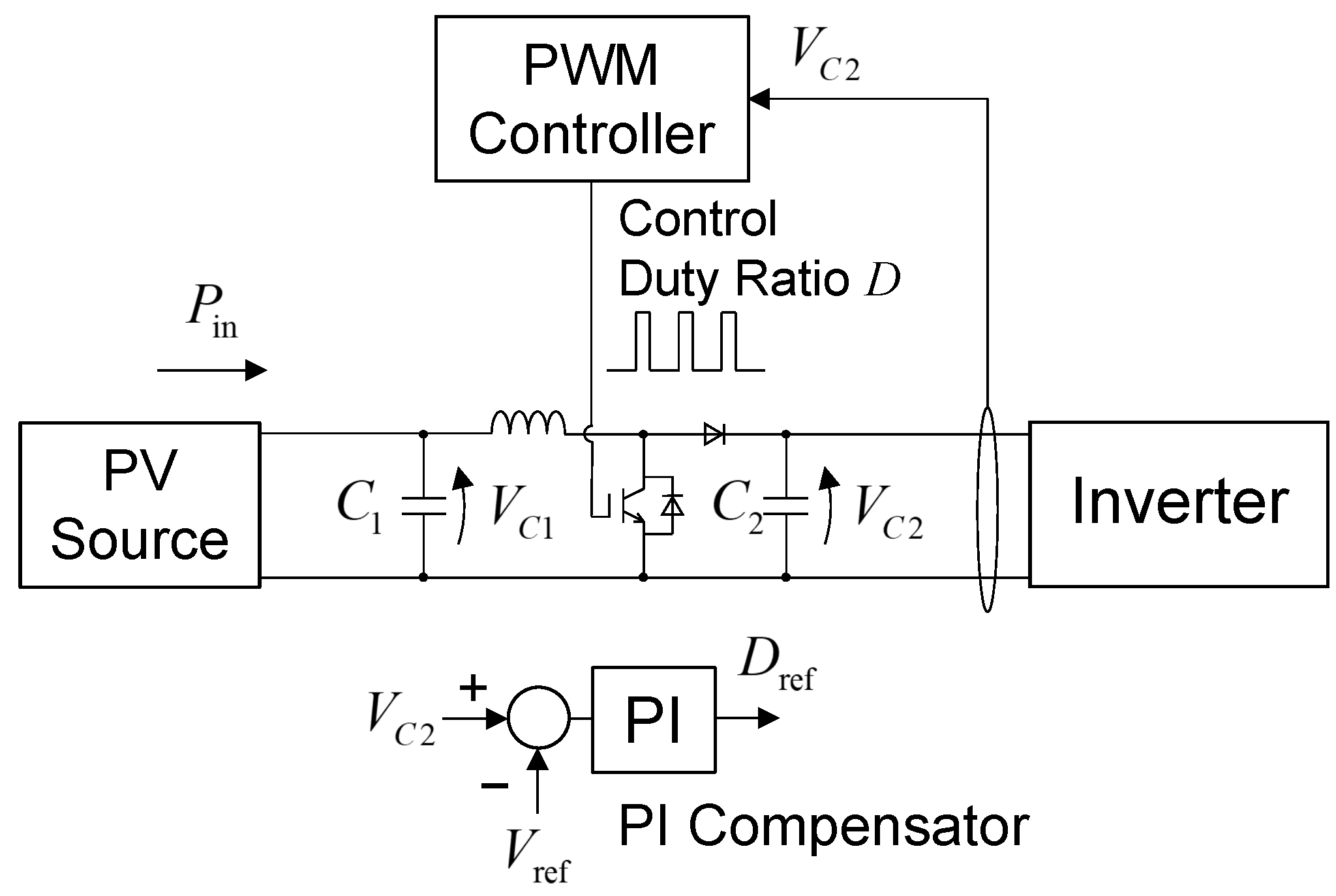
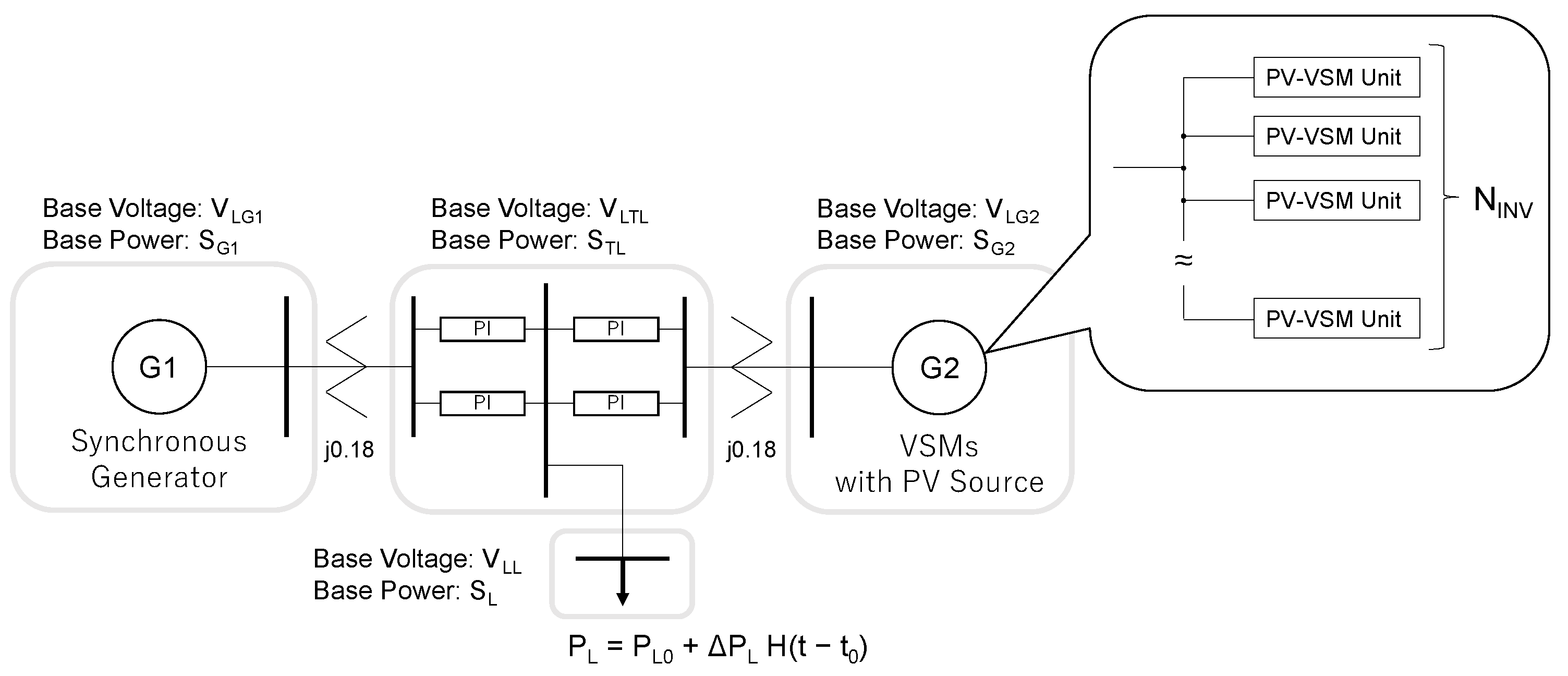

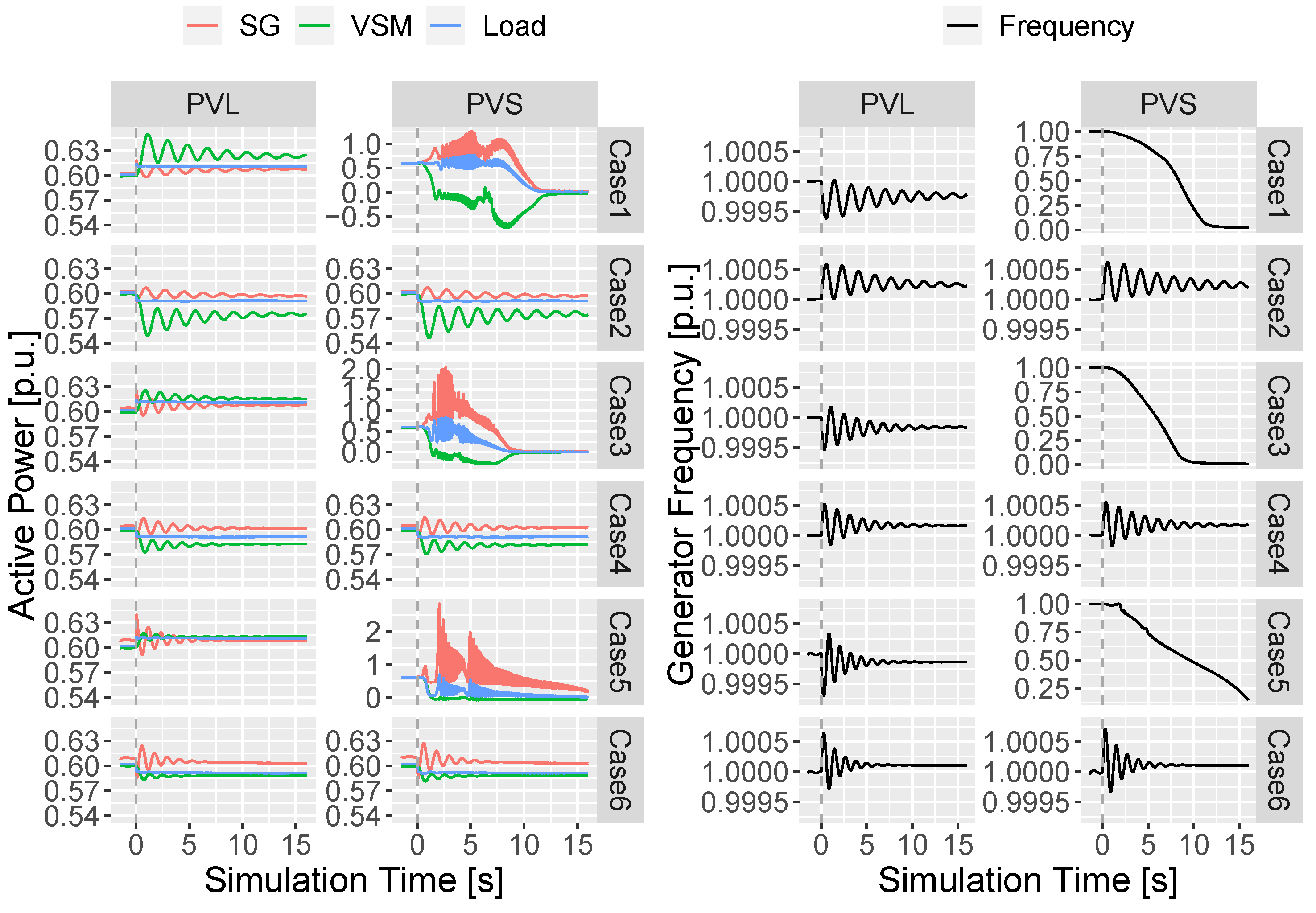

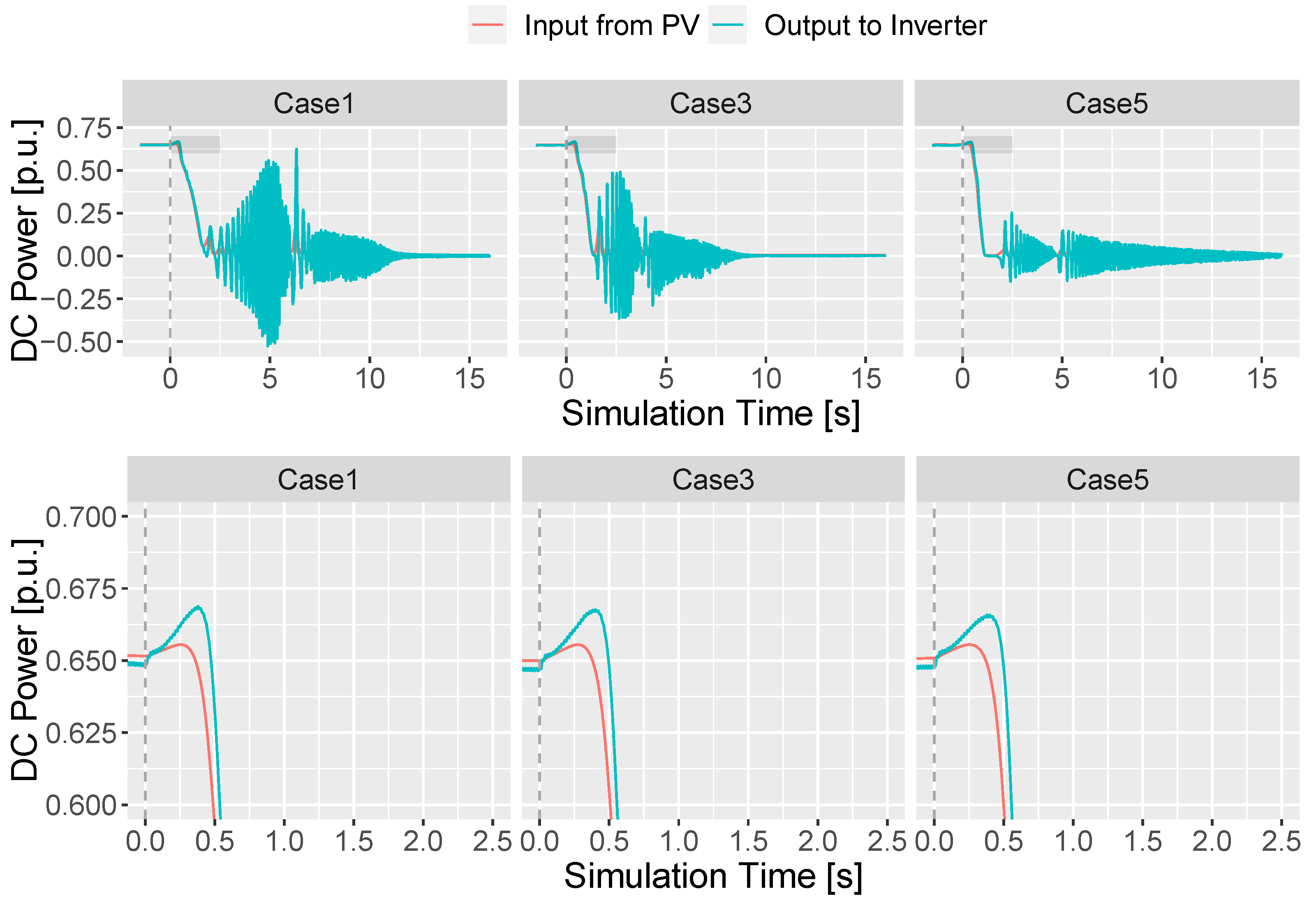

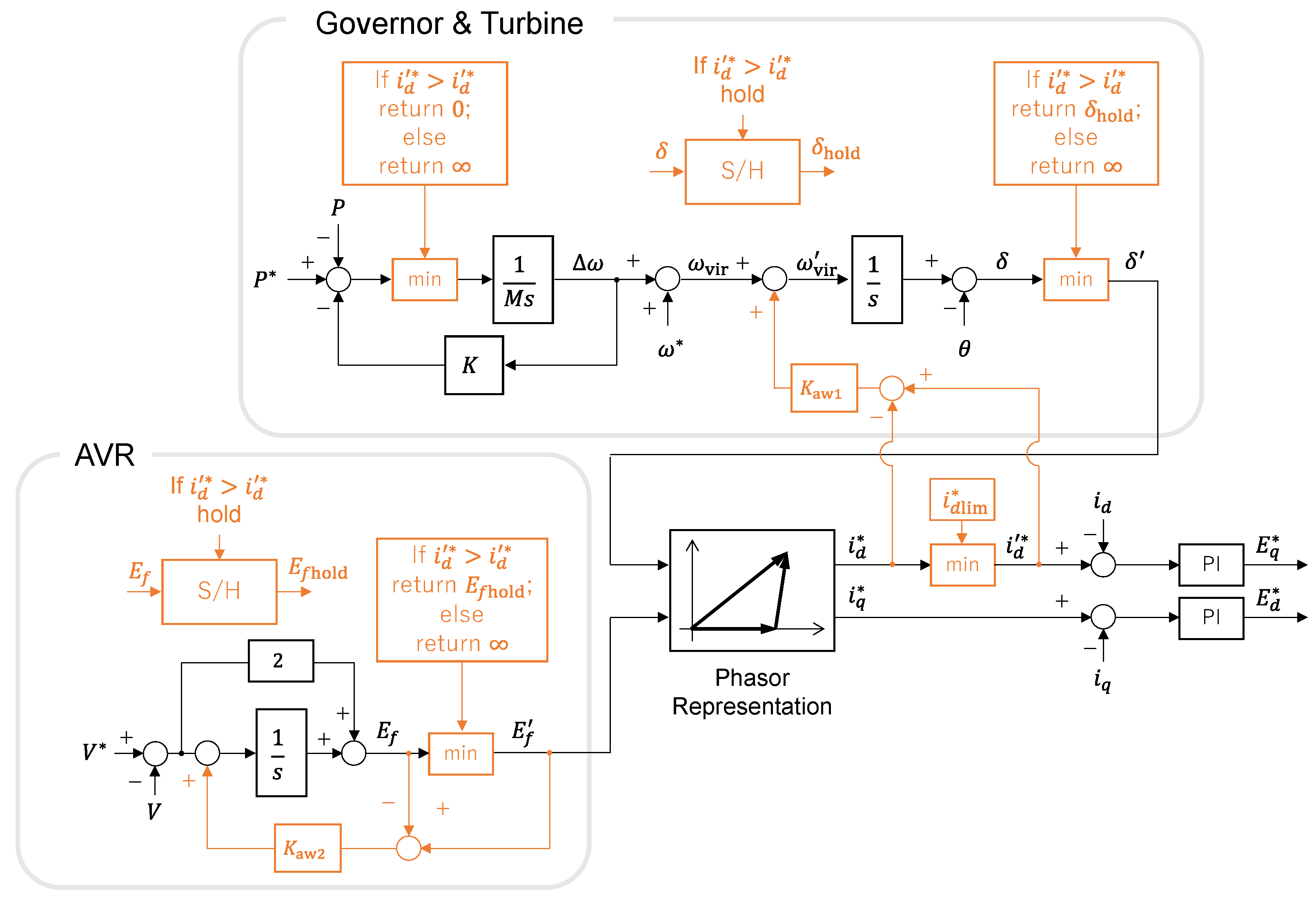

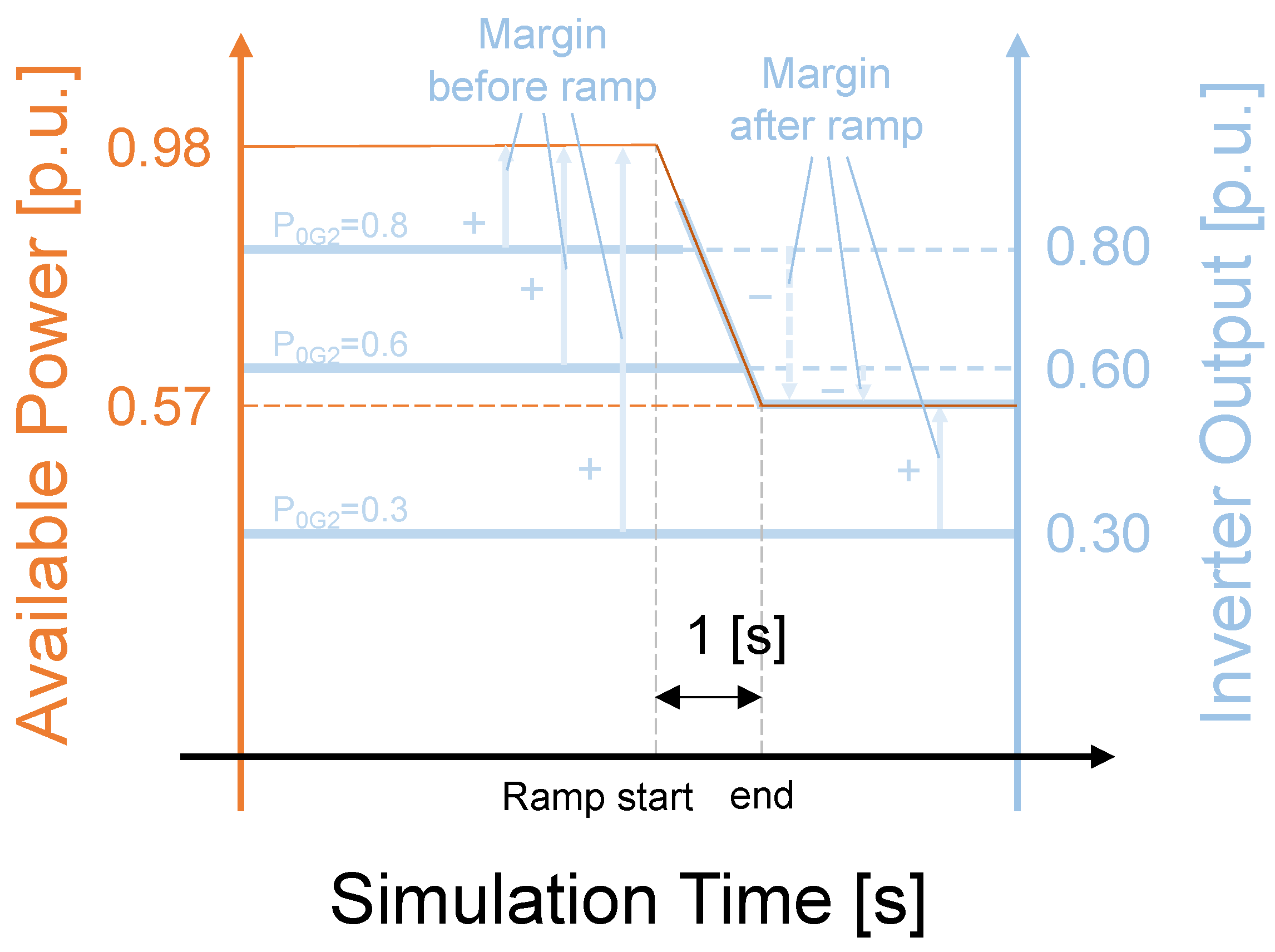
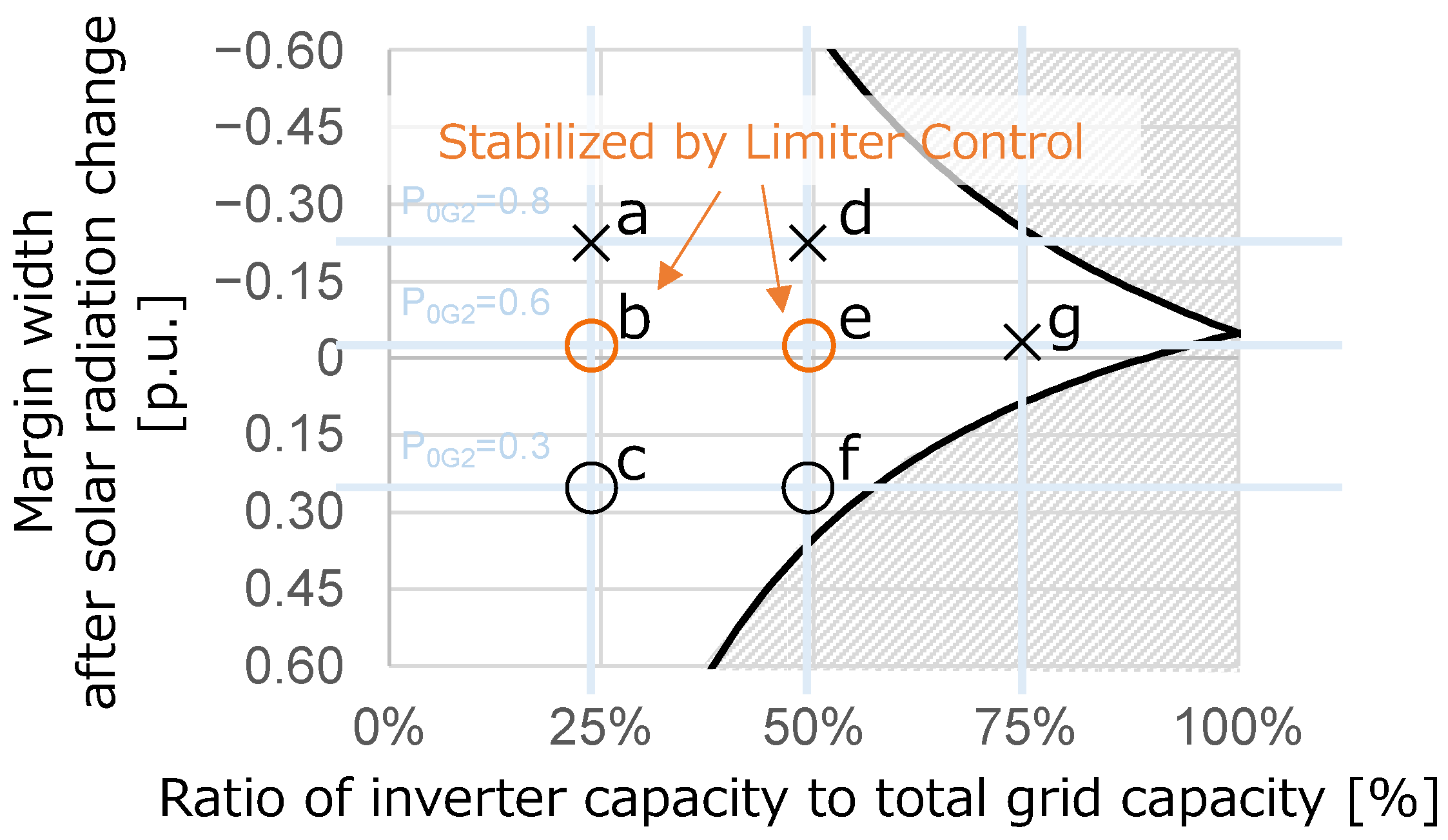


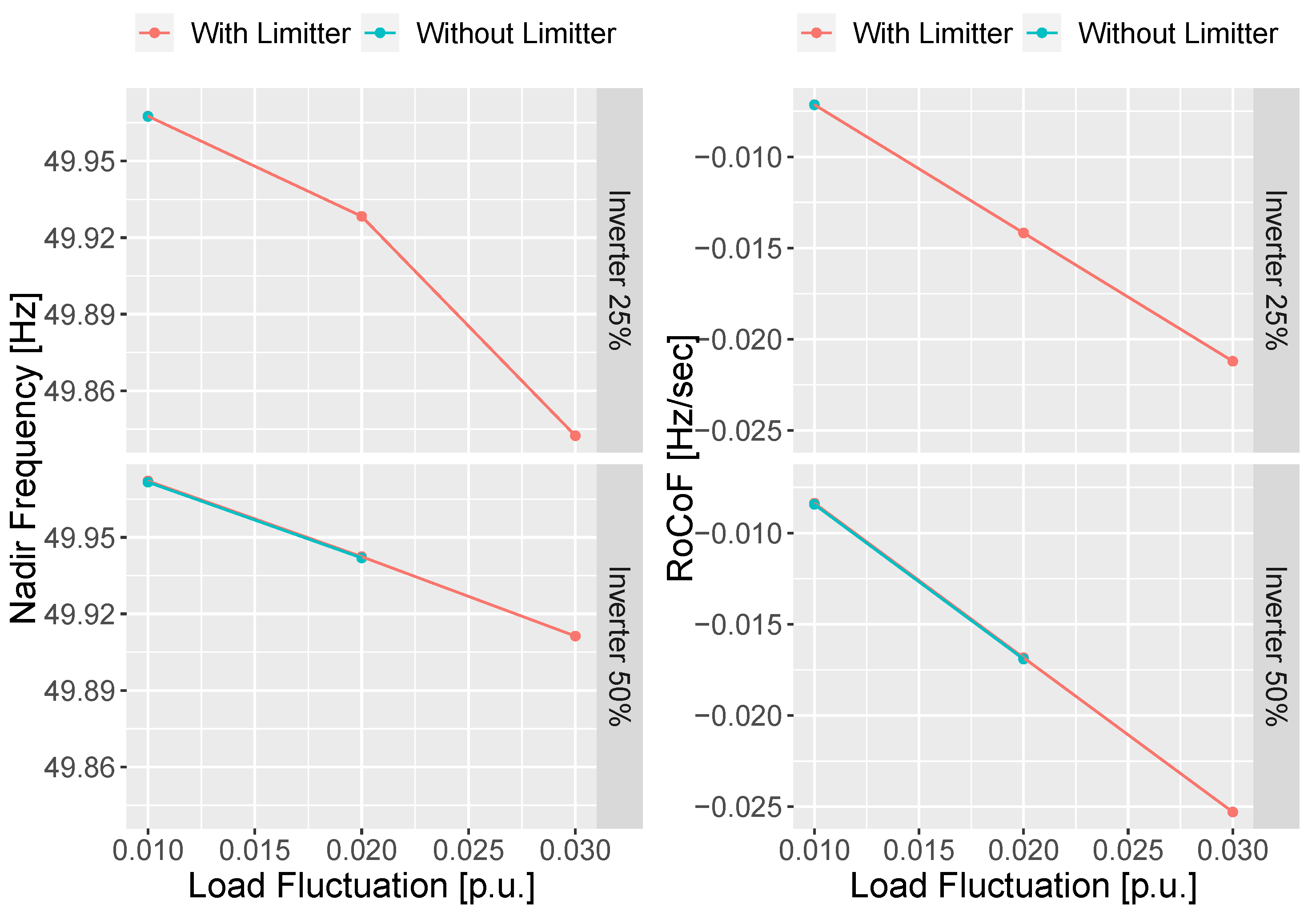
| Boost converter | |||
| Primary side capacitor | |||
| Secondary side capacitor | |||
| Inductor | L | 250 | |
| Primary side voltage | 340 (Rated voltage) | ||
| Secondary side voltage | 680 (Rated voltage) | ||
| PV Source | |||
| Series resistance per cell | 0.02 | ||
| Shunt resistance per cell | 1000 | ||
| Number of cell connected in series | PV-L : 455 | PV-S : 495 | |
| Number of cell connected in parallel | PV-L : 136 | PV-S : 83 | |
| Maximum power | PV-L : 98.2 [kW] | PV-S : 65.5 [kW] | |
| Voltage at maximum power point | PV-L : 316 [V] | PV-S : 337 [V] | |
| Short circuit current | PV-L : 340 [A] | PV-S : 207 [A] | |
| Open circuit voltage | PV-L : 380 [V] | PV-S : 413 [V] | |
| MPPT Control | Constant Voltage Control | |
|---|---|---|
| Primary Side | Secondary Side | |
| × | × | ∘ |
| Synchronous generator (G1) | ||
| Rated line voltage | 100 [kV] | |
| Base power (Rated power) | Variable [MVA] | |
| Inertia constant | 3.5 [s] | |
| Governor gain | 25 [p.u.] | |
| Synchronous reactance (d-axis) | 1.72 [p.u.] | |
| Synchronous reactance (q-axis) | 1.66 [p.u.] | |
| Initial power output | Variable [p.u.] | |
| Transmission line | ||
| Rated line voltage | 500 [kV] | |
| Base power | 1000 [MVA] | |
| Resistance of -section lines | [p.u.] | |
| Reactance of -section lines | [p.u.] | |
| Susceptance of -section lines | [p.u.] | |
| Inverter base resources (G2) | ||
| Rated line voltage | 100 [kV] | |
| Base power | Variable [MVA] | |
| Virtual inertia constant | 25 [s] | |
| Virtual governor gain | 100 [p.u.] | |
| Virtual synchronous reactance | [p.u.] | |
| Initial power output | Variable [p.u.] | |
| Load | ||
| Rated line voltage | 500 [kV] | |
| Base power | 2000 [MVA] | |
| Initial power consumption | 0.6 [p.u.] | |
| Load power fluctuation | Variable [p.u.] | |
| [MVA] | [p.u.] | [MVA] | [p.u.] | [p.u.] | |
|---|---|---|---|---|---|
| Case1 | 1500 | 0.6 | 500 | 0.6 | |
| Case2 | 1500 | 0.6 | 500 | 0.6 | |
| Case3 | 1000 | 0.6 | 1000 | 0.6 | |
| Case4 | 1000 | 0.6 | 1000 | 0.6 | |
| Case5 | 500 | 0.6 | 1500 | 0.6 | |
| Case6 | 500 | 0.6 | 1500 | 0.6 |
| [MVA] | [p.u.] | [MVA] | [p.u.] | [p.u.] | |
|---|---|---|---|---|---|
| Case a | 1500 | 0.53 | 500 | 0.8 | 0 |
| Case b | 1500 | 0.6 | 500 | 0.6 | 0 |
| Case c | 1500 | 0.7 | 500 | 0.3 | 0 |
| Case d | 1000 | 0.4 | 1000 | 0.8 | 0 |
| Case e | 1000 | 0.6 | 1000 | 0.6 | 0 |
| Case f | 1000 | 0.9 | 1000 | 0.3 | 0 |
| Case g | 500 | 0.6 | 1500 | 0.6 | 0 |
| [MVA] | [p.u.] | [MVA] | [p.u.] | [p.u.] | |
|---|---|---|---|---|---|
| Case a1 | 1500 | 0.53 | 500 | 0.8 | |
| Case a2 | 1500 | 0.53 | 500 | 0.8 | |
| Case a3 | 1500 | 0.53 | 500 | 0.8 | |
| Case d1 | 1000 | 0.4 | 1000 | 0.8 | |
| Case d2 | 1000 | 0.4 | 1000 | 0.8 | |
| Case d3 | 1000 | 0.4 | 1000 | 0.8 |
Publisher’s Note: MDPI stays neutral with regard to jurisdictional claims in published maps and institutional affiliations. |
© 2022 by the authors. Licensee MDPI, Basel, Switzerland. This article is an open access article distributed under the terms and conditions of the Creative Commons Attribution (CC BY) license (https://creativecommons.org/licenses/by/4.0/).
Share and Cite
Takamatsu, T.; Oozeki, T.; Orihara, D.; Kikusato, H.; Hashimoto, J.; Otani, K.; Matsuura, T.; Miyazaki, S.; Hamada, H.; Miyazaki, T. Simulation Analysis of Issues with Grid Disturbance for a Photovoltaic Powered Virtual Synchronous Machine. Energies 2022, 15, 5921. https://doi.org/10.3390/en15165921
Takamatsu T, Oozeki T, Orihara D, Kikusato H, Hashimoto J, Otani K, Matsuura T, Miyazaki S, Hamada H, Miyazaki T. Simulation Analysis of Issues with Grid Disturbance for a Photovoltaic Powered Virtual Synchronous Machine. Energies. 2022; 15(16):5921. https://doi.org/10.3390/en15165921
Chicago/Turabian StyleTakamatsu, Takahiro, Takashi Oozeki, Dai Orihara, Hiroshi Kikusato, Jun Hashimoto, Kenji Otani, Takahiro Matsuura, Satoshi Miyazaki, Hiromu Hamada, and Teru Miyazaki. 2022. "Simulation Analysis of Issues with Grid Disturbance for a Photovoltaic Powered Virtual Synchronous Machine" Energies 15, no. 16: 5921. https://doi.org/10.3390/en15165921
APA StyleTakamatsu, T., Oozeki, T., Orihara, D., Kikusato, H., Hashimoto, J., Otani, K., Matsuura, T., Miyazaki, S., Hamada, H., & Miyazaki, T. (2022). Simulation Analysis of Issues with Grid Disturbance for a Photovoltaic Powered Virtual Synchronous Machine. Energies, 15(16), 5921. https://doi.org/10.3390/en15165921






